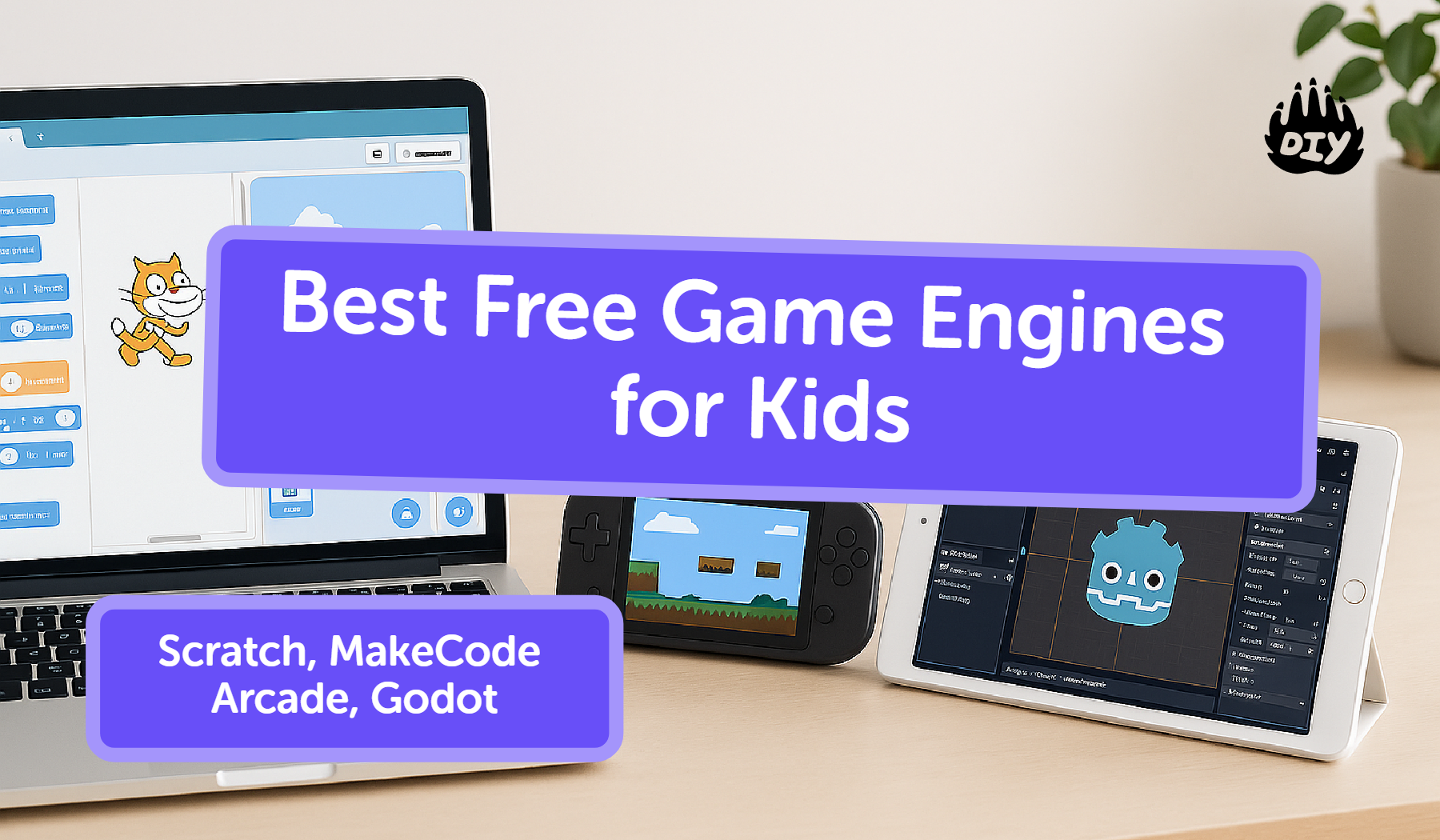Helping a kid make games in 2025? Start with Scratch (visual blocks, fast wins), move to MakeCode Arcade (blocks → JavaScript for 2D retro games), then step up to Godot (full 2D/3D engine with real scripting). Pick by age, device, and project goals, not hype.
Stuck on sprites, story, or rules? Paste your goal into DIY’s AI Homework Helper for gentle prompts, step-by-step plans, and a quick playtest checklist. → Try AI Homework Helper
How to choose a kid-friendly engine in 2025
Age & reading level: Blocks are best for beginners; text code comes later. Scratch uses visual blocks; MakeCode lets kids peek at JavaScript; Godot teaches real engine structure.
Device & install limits: Scratch and MakeCode Arcade run in the browser (great for Chromebooks). Godot needs a desktop install.
Project goals: 2D arcades and classroom quick wins → Scratch/MakeCode. Bigger ambitions (2D/3D) → Godot
Support & community: Scratch has an enormous remix culture; MakeCode has classroom docs; Godot has active releases and docs.
Quick comparison (at a glance)
Engine | Best for ages | Coding style | Runs on | Typical projects | Learning curve | Cost |
~8–16 | Visual blocks | Browser (Chromebooks, PCs/Macs) | Stories, platformers, clickers | Easiest | Free | |
~9–14 | Blocks + JavaScript | Browser, Chromebooks, handhelds | Retro 2D games with sprites/tilemaps | Easy–medium | Free | |
~12+ (with guidance) | GDScript/C#/Visual | Windows/Mac/Linux editor | 2D/3D indie-style games | Medium–advanced | Free, open source (MIT) |
Use the Helper to outline a “one-room” game, generate task lists (“what to do first”), and draft patch notes after testing. Start here → https://www.diy.org/ai-homework-helper
Scratch (visual blocks; perfect first step)
Why it clicks: Drag-and-drop blocks, instant feedback, a huge gallery to remix. It’s designed for kids and runs in the browser, which makes classroom setups easy.
Starter builds: clicker, dodge game, simple platformer, interactive story (see Starter Projects for examples).
Level-up path: variables → clones → custom blocks → basic physics.
Pro tip: “Remix then tweak” teaches quickly thanks to Scratch’s built-in remix culture.
MakeCode Arcade (blocks → JavaScript for retro games)
Why it stands out: Kids start in blocks, then open the JavaScript view to see their code; it’s built for 2D sprites, tilemaps, and classic arcade mechanics.
Starter builds: top-down collect, flappy clone, tilemap platformer.
Level-up path: switch to JS for state machines, scoring, and enemy behavior; classroom docs make it easy to scaffold lessons.
Godot (free, open source, 2D/3D when they’re ready)
Why it’s compelling: Modern editor, scene/node system, great 2D tools, growing 3D; scripts in GDScript or C#; permissive MIT license (no royalties).
Good first projects: tiny 2D platformer, endless runner, top-down adventure (move → collide → collect → win/lose).
What’s new in 2025: Godot 4.4+ focuses on quality-of-life improvements and performance (load times, stutter, editor comfort).
Age-based learning ladder
Ages 7–9: Scratch mini-games (one room, one goal).
Ages 9–12: MakeCode Arcade (blocks → JS), sprites/tilemaps, score, simple AI.
Ages 12+: Godot 2D scenes, input, collisions; try small 3D later.
Devices & setup (school-friendly)
Zero/low-install: Scratch, MakeCode Arcade run in the browser; Chromebook-ready.
Desktop needed: Godot editor for Windows/Mac/Linux; export to many platforms.
Starter project ideas (weekend-friendly)
Scratch: clicker with win state → add timer → add levels.
MakeCode Arcade: tilemap platformer with coins → add enemies → add boss.
Godot: 2D runner (input, collisions, score) → add scenes → polish with UI.
Skills kids actually build
Systems thinking, debugging, art/story integration, sharing/feedback. Scratch’s community highlights playful remixing; Godot teaches scene composition and scripting; MakeCode bridges blocks to JavaScript.
Safety & sharing (for parents/teachers)
Use classroom modes and sharing guidelines on each platform; review community rules before posting projects. (Link these in your CMS to each official page.)
Engine | Ideal Ages | What It Teaches First | Project Types | Setup | Level-Up Path | Cost |
Scratch | ~8–16 | Sequencing, events, loops via blocks | Story games, clickers, platformers | Browser | Variables → clones → custom blocks | Free (scratch.mit.edu) |
MakeCode Arcade | ~9–14 | Blocks with instant JavaScript view | Retro 2D, sprites/tilemaps | Browser/Chromebooks | Open JS tab → state machines → scoring | Free (Microsoft MakeCode Arcade) |
Godot (4.x) | ~12+ | Scenes/nodes, scripting (GDScript/C#) | 2D/3D indie-style | Desktop app | 2D first → UI → try small 3D | Free (MIT) (docs.godotengine.org) |
FAQs
Is Scratch a “real” engine?
It’s a real programming environment built for learning game logic perfect for fundamentals and quick prototypes. scratch.mit.edu
Can my child outgrow MakeCode Arcade?
Yes JavaScript basics transfer nicely to engines like Godot as they move beyond blocks. Microsoft MakeCode Arcade
Why not start with Unity or Unreal?
They’re powerful but heavier to install and teach. Godot offers a gentler, free path for beginners aiming at “real engine” workflows.


